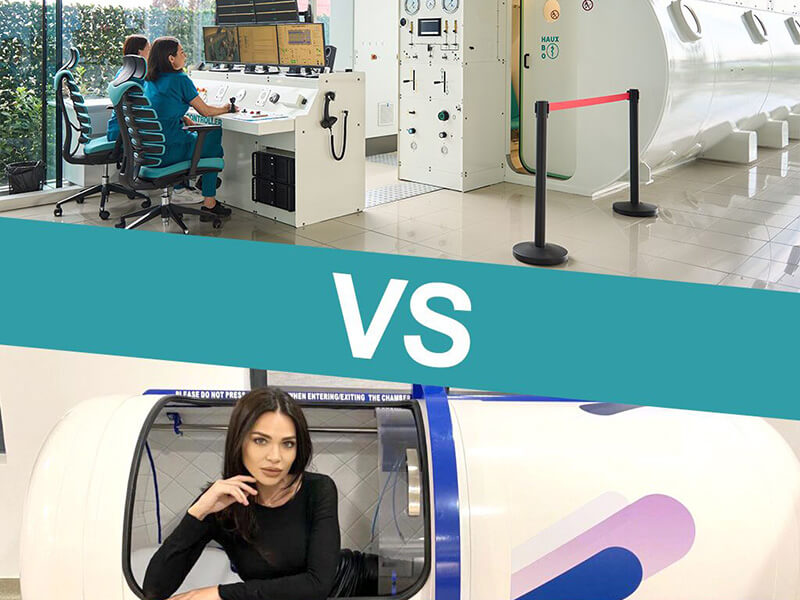
Article reviewed by: Dr. Sturz Ciprian, Dr. Tîlvescu Cătălin and Dr. Alina Vasile
HBOT's effectiveness in treating slow-healing wounds
HBOT or hyperbaric oxygen therapy is a treatment method that involves breathing almost pure oxygen in a specially designed chamber. This chamber is resistant to high pressures, which is necessary for HBOT because it involves oxygen at higher than normal atmospheric pressures.
In 1662, the first hyperbaric chamber was created, and it was believed that the pressure in it could help treat certain respiratory diseases. Since the 1940s, hyperbaric oxygen therapy has even become a treatment of choice for military divers in the United States. Nowadays, the main use of hyperbaric oxygen therapy is in the treatment of diseases related to exposure to large pressure differences, for example in divers or athletes, but it is also brought to the fore as a treatment for other health conditions, such as some infections, eye disorders, skin lesions, burns, anaemia, etc. In addition, HBOT is a therapy that can also be of great benefit in treating wounds that are difficult to heal, for example, diabetic foot ulcers.
How does HBOT work?
The body's tissues need oxygen to function at optimal levels, and the supplemental oxygen associated with hyperbaric oxygen therapy can help improve cell function and heal damaged tissues. In this therapy, oxygen is breathed intermittently at a concentration of almost 100% in a special chamber, called a hyperbaric chamber, which has a higher pressure than at sea level.
The ambient pressure inside a hyperbaric chamber is three times higher than the air pressure people normally breathe. Breathing pure oxygen at this pressure will increase the concentration of oxygen available to the lungs by up to three times. The number and duration of sessions depend on the reason for treatment. A session can last from 30 minutes to several hours. For wounds that are slow to heal, hyperbaric therapy can help speed up the healing process by increasing blood flow and oxygenating affected tissues. It can also help reduce infection and prevent amputation. However, it should be borne in mind that this therapy can also be useful when it supports other treatments, such as drugs or surgery.
Which wounds are hard to heal?
There are some injuries whose healing process is not optimal, and because of this serious delays and even severe complications occur. Abnormal, poor blood circulation, especially in the legs, can be the cause of certain lesions, especially when associated with diabetes. Diabetic foot ulcers are the most common complication of diabetes, caused by peripheral neuropathy, small vessel occlusion and secondary infections or trauma. All this must be taken seriously, as ulcers of this type can become complicated and even lead to amputation of the lower limbs.
There are other hard-to-heal wounds besides diabetic foot ulcers, and examples include varicose ulcers, scars, peripheral arterial disease, burns, post-surgical injuries, skin grafts and arterio-ulcerative malformations. Hyperbaric oxygen therapy can help in the healing process of all these injuries, as the oxygen in high doses will be used by the cells in a short time and will reach the tissues where there is a deficiency. The increased diffusion of oxygen into the tissues in this way will accelerate the healing process by compensating for compromised perfusion.
HBOT in diabetic foot ulcer
As previously stated, hyperbaric oxygen therapy is a treatment option that involves a person breathing almost pure oxygen in a special chamber. Evidence suggests that HBOT may have a variety of applications, including wound healing. Because of this, it can help treat diabetic foot ulcers.
A 2018 study found that hyperbaric oxygen therapy was effective in treating 74.2% of diabetes-associated ulcers. The use of HBOT has significantly improved the healing process of ulcerative lesions compared to other treatment methods.
During the natural wound-healing process, the body uses oxygen to stimulate healing and the production of new tissue. Hyperbaric oxygen therapy stimulates the formation of new blood vessels around the affected area, and these will supply the area with even more oxygen. This influx of oxygen and nutrients will help generate new and healthy tissue. However, specialists note that although HBOT reduces the rate of amputations, it can have variable effectiveness and may have much better effects if combined with other treatment methods. Thus, discussion with the doctor is very important before any therapy, as other treatment options, including surgical ones such as excisional debridement of devitalised tissues, may be necessary.
HBOT may offer several potential benefits for people experiencing diabetic foot ulcers. The main benefit is that it can speed up the healing process. A much faster recovery time can help people living with diabetes regain the benefits of an active lifestyle and reduce the risk of complications associated with diabetes and diabetic foot ulcers. A 2020 systematic review on the topic adds that in addition to promoting healing, hyperbaric oxygen therapy can also help reduce serious adverse events such as wound infection and lower limb amputation, as well as improve quality of life.
Hyperbaric oxygen therapy for bedsores
Bedsores, also called pressure ulcers, are localised lesions in the skin and underlying tissue that occur due to pressure, specifically due to the blockage of oxygen-rich blood to the tissue. These lesions often form in people who are bedridden, wheelchair-bound or who do not change position easily. Decubitus ulcers usually occur near bony planes because the pressure there is greater than on soft tissue. The heels, ankles, spine, hips and elbows are the areas most prone to developing bedsores.
Decreased mobility and activity are the main causes of pressure ulcers, but they are more likely to develop when there are increased moisture, friction, and foreign bodies that do not allow the skin to breathe (crumbs, bedding creases, etc.).
Pressure ulcers occur when the blood supply to an area of the skin is interrupted. Hyperbaric oxygen therapy is a specialised and natural medical treatment that provides a rapid increase in oxygen levels to a site of skin that has been injured, is devitalised or has necrotic tissue. Oxygen is a key element in healing scars, and exposure to oxygen-rich environments can trigger the healing process in the skin while controlling the inflammatory phase.
Hyperbaric oxygen therapy in varicose ulcers
Varicose leg ulcers are skin lesions caused by chronic venous insufficiency. According to studies, about 4% of people with chronic venous insufficiency also develop leg ulcers. The pathophysiology of varicose ulcer is based on venous hypertension, which can be caused by deep vein thrombosis, venous hypertension, venous insufficiency itself or decreased pumping action of the calf muscles.
There are drug and surgical treatment options to correct associated vascular disorders, but the gold standard is compression bandaging. It aims to counteract the increased hydrostatic pressure from chronic venous insufficiency so that venous return is increased. However, even with these evidence-based treatment options, 33-60% of ulcers remain unhealed after 6 weeks, and 15-30% persist even after a year of compression therapy. Thus, the use of hyperbaric oxygen therapy as a treatment in these cases is very often successfully attempted. Improving tissue oxygenation and therefore healing of varicose ulcer-associated lesions is the main rationale for hyperbaric oxygen therapy. The hyperoxic state in hyperbaric chambers will lead to increased production of 'signalling' molecules for growth and healing factors, cytokines and hormones. This will also lead to increased angiogenesis, modulation of inflammatory activity, improved collagen deposition and reduced oedema.
Studies of hyperbaric oxygen therapy in varicose ulcers are few but have shown that this therapy has real potential, especially as an additional therapy when other treatment methods have failed or have not been effective.
Conclusions
Medical experts endorse the use of hyperbaric oxygen therapy to treat hard-to-heal wounds such as diabetic foot ulcers or bedsores. The procedure involves a person entering a special pressurised chamber and breathing almost pure oxygen. This increases the amount of oxygen in the blood, including stimulating oxygen flow to the wound, which promotes healing.
It should be known that there are not many studies for all the conditions in which this therapy is effective, but research continues. Thus, hyperbaric oxygen therapy should be carried out on the doctor's advice and in accordance with specialist recommendations. It should also be taken into account that, in addition to its many beneficial effects, HBOT also has some risks for side effects such as sinus and ear damage, lung damage, seizures, hypoglycaemia, panic attacks associated with claustrophobia etc. However, most side effects are mild and people can avoid them if they follow the instructions and if the sessions are organised correctly.
References:
What is hyperbaric oxygen therapy good for?; https://www.medicalnewstoday.com/articles/313155
Hyperbaric oxygen therapy; https://www.mayoclinic.org/tests-procedures/hyperbaric-oxygen-therapy/about/pac-20394380
Why You Shouldn’t Ignore a Wound That Won’t Heal; https://health.clevelandclinic.org/why-you-shouldnt-ignore-a-wound-that-wont-heal/
Improved Healing of Diabetic Foot Ulcer upon Oxygenation Therapeutics through Oxygen-Loading Nanoperfluorocarbon Triggered by Radial Extracorporeal Shock Wave; https://www.hindawi.com/journals/omcl/2019/5738368/?utm_source=google&utm_medium=cpc&utm_campaign=HDW_MRKT_GBL_SUB_ADWO_PAI_DYNA_JOUR_X_PJ_Sitelink_10authordiscount&gclid=Cj0KCQiAq5meBhCyARIsAJrtdr7eyvXEqQ3XyaHiBwYBknmf2nXuane4ilYi5oGz9Du1GTcf9tjcn6YaAsssEALw_wcB
Can pressure ulcers heal? yes, and hbot can help!; https://r3healing.com/can-pressure-ulcers-heal-yes-and-hbot-can-help/
Does HBOT promote the healing of diabetic foot ulcers?; https://www.medicalnewstoday.com/articles/hyperbaric-oxygen-therapy-for-diabetic-foot-ulcers
Oxygen therapy in varicose veins: Improvement of the microcirculation in the legs – Casuistic;https://www.pulsus.com/scholarly-articles/oxygen-therapy-in-varicose-veins-improvement-of-the-microcirculation-in-the-legs--casuistic.pdf
Hyperbaric Oxygen Therapy for Venous Leg Ulcers: A 6 Year Retrospective Study of Results of a Single Center;https://www.frontiersin.org/articles/10.3389/fmed.2021.671678/full




